Victor Servranckx
Diegen, 1897-Elewijt, 1965
Victor Servranckx became one of the first Belgian artists to espouse abstraction. He studied at the Brussels Académie des Beaux-Arts from 1913 to 1917 and, after completing his studies, began working at the Peters-Lacroix wallpaper factory, where he designed abstract motifs. Servranckx’s lengthy collaboration with this firm (until 1925), where he met René Magritte, spurred him to take an interest in interior decoration and interior design. Also during this period he exhibited his paintings for the first time at the Giroux gallery in Brussels in 1917.
In 1918 Servranckx began to exhibist his oeuvre in L’Effort Moderne, Léonce Rosenberg’s Paris gallery, which had been a meeting place for the members of the Cubist movement since the First World war. He met Filippo Tommaso Marinetti, Theo van Doesburg, Fernand Léger and Marcel Duchamp, and thereafter his work was shown in numerous solo and group exhibitions. In 1926, thanks to Marcel Duchamp, he took part in the exhibitions of the Société Anonyme in the United States and received an invitation from László Moholy- Nagy to teach at the New Bauhaus in Chicago, which he rejected.
Servranckx produced abstract sculptures and collages and was an active contributor to the magazines Sept Arts and Opbouwen. From 1932 to 1935 he taught at the École des Arts Industriels et Décoratifs d’Ixelles and, although his work had a largely hostile reception in Belgium, his influence on subsequent generations of artists was significant. He was selected at the 1948 and 1954 Venice Biennales and in 1965, shortly before his death, the Musée d’Ixelles held a retrospective of his work.
In 1918 Servranckx began to exhibist his oeuvre in L’Effort Moderne, Léonce Rosenberg’s Paris gallery, which had been a meeting place for the members of the Cubist movement since the First World war. He met Filippo Tommaso Marinetti, Theo van Doesburg, Fernand Léger and Marcel Duchamp, and thereafter his work was shown in numerous solo and group exhibitions. In 1926, thanks to Marcel Duchamp, he took part in the exhibitions of the Société Anonyme in the United States and received an invitation from László Moholy- Nagy to teach at the New Bauhaus in Chicago, which he rejected.
Servranckx produced abstract sculptures and collages and was an active contributor to the magazines Sept Arts and Opbouwen. From 1932 to 1935 he taught at the École des Arts Industriels et Décoratifs d’Ixelles and, although his work had a largely hostile reception in Belgium, his influence on subsequent generations of artists was significant. He was selected at the 1948 and 1954 Venice Biennales and in 1965, shortly before his death, the Musée d’Ixelles held a retrospective of his work.






